Contents
Standard raspberry differs from garden raspberries in thickness and woody stem structure. The strongest shoot is chosen, a bole is formed, the rest are removed. If you do not trim, you get an ordinary thickened bush.
What does standard raspberry mean
The natural form of the culture is bushy, the height and volume depend on the variety (it is a hybrid or a variety), the place of growth. Raspberries form quite a lot of basal shoots during the season, which have to be removed. Agricultural technology consists of pruning, fixing the stems to the support, especially if it is a tall bush.
Most of the shortcomings were eliminated by selection in 1986, when Professor Kichina V.V. created a culture with 1-3 stable, tough and rather thick stems for raspberries. This variety requires molding only at the beginning of growth. The lower part of the trunk (trunk) is bare, then there are skeletal branches in several orders.
This form does not require shelter for the winter, it simplifies the collection of berries. According to the reviews of gardeners who grow raspberries on a trunk, it is more productive than an ordinary bush, it is less affected by a fungus, because air circulates better in the inner part of the crown. But the root system for all species is the same, so it will not be possible to completely get rid of the shoots, it should be removed.
Raspberries on the trunk (pictured) are clearly different from the bush representatives.
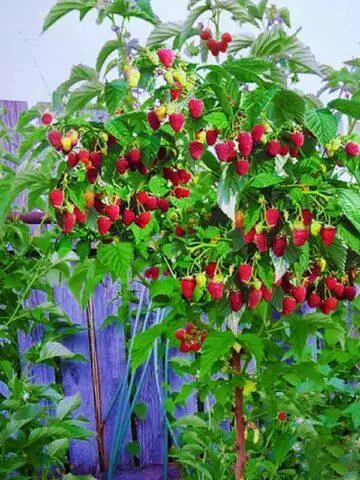
Visually, the stem culture looks like a tree
Advantages and disadvantages
Standard varieties have their own merits, for which gardeners appreciate them.
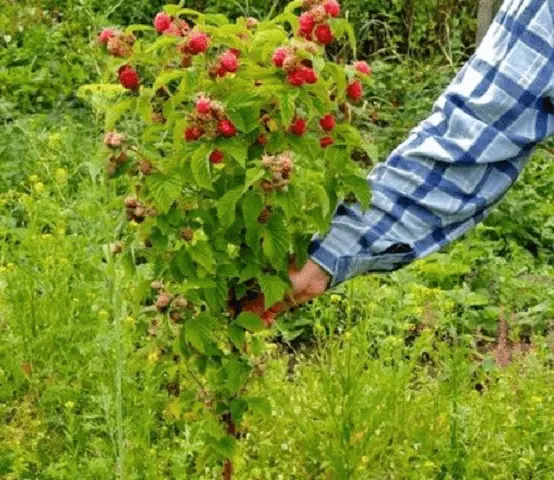
The plant on the trunk gives a good harvest
Pros:
- stable yield;
- remontance;
- large-fruited;
- frost resistance, most of the standard raspberry varieties can be grown in the Moscow region, in the Urals, in the Middle lane;
- elastic and strong stems that easily support the weight of the fruit;
- vegetation does not slow down in partial shade; berries do not bake in the sun;
- does not require shelter of the crown for the winter;
- has strong immunity to infections.
Cons:
- For full growth, more space is needed than for the bush variety.
The best varieties of standard raspberries
For cold regions, frost resistance is a priority, for southern regions – the ability to withstand high temperatures and a dry climate. There are old time-tested standard varieties and relatively recently created, new raspberry hybrids.
Tarusa
Variety Tarusa (Tarusa) – one of the first non-remontant varieties. Created in 1992. Experimental cultivation showed good frost resistance (-250 C), but poor response to high air and soil humidity. Standard raspberries are recommended for growing in areas with a dry climate.
General characteristics:
- The height and volume of the crown is within 1,5 m.
- The lower part of the central stem without shoots, they begin to form 1/3 of the length, branched, without thorns.
- Coverage is intense.
- Large-fruited raspberries, bright red berries, weighing 15 g, cone-shaped with a blunt end, length – 5 cm.
- The taste is sweet and sour, the drupes are large, the planting is dense, the pulp is juicy with a pronounced aroma.
4-5 kg of berries are harvested from one raspberry bush.
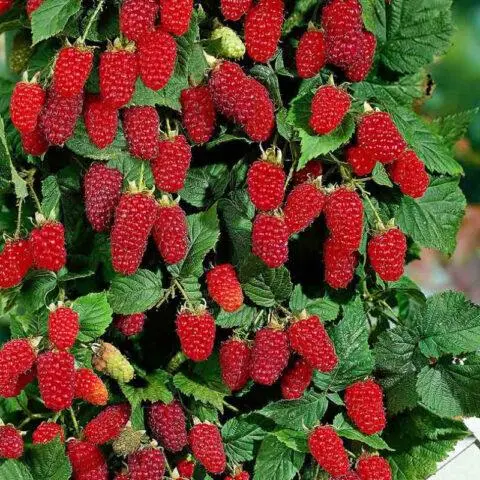
Tarusa ripens from mid-July to the second decade of August
Galaxy
Galaxy (Galaxy) is a relatively new variety of standard raspberry of a semi-repair type. Active fruiting begins in mid-July and lasts three weeks. The second wave is characterized by the appearance of single berries on 20% of young shoots. Starts from the second half of August.
The culture is suitable for growing in all climatic zones, where winter temperatures do not fall below -28 0C. The galaxy tolerates drought and high humidity well.
Characteristic:
- The standard part of the raspberry is short. The variety forms powerful stems with very long laterals with a dense arrangement of berries.
- Plant height up to 2 m. Stem formation and formation of root shoots are intensive. Thorns in the form of rudiments are observed only at the base of perennial shoots.
- Fruits weighing up to 18 g, dark red, with a matte sheen. The shape is slightly elongated, the seeds are small.
- The skin is thin, raspberries are not transportable. It cannot be kept fresh.
- The taste is sweet, the structure is soft, juicy.
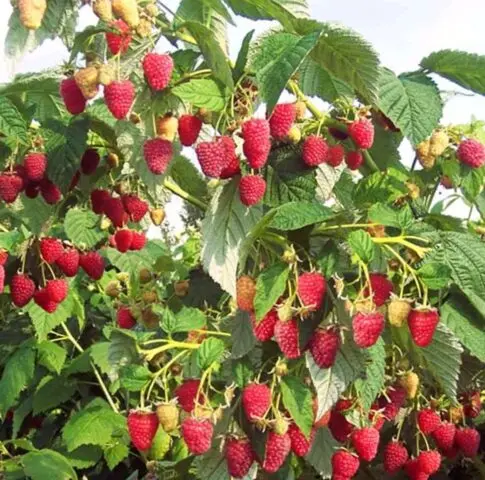
Productivity of the Galaxy – 4 kg from one bush
Penguin
Standard raspberry Penguin (Penguin) remontant type. Bred in 2006 for cultivation in the Middle lane and the Moscow region. Frost resistance – 250 C. Responds well to drought and overwatering. It does not get sick, pests practically do not affect the culture. Penguin is one of the high-yielding standard varieties. Up to 6 kg can be collected from a bush.
Characteristic:
- Raspberries are medium-sized – up to 1,2 m.
- Stems are powerful, with short internodes.
- Escape is weak.
- There are practically no root shoots.
- The berries are round, dark crimson. Weight – 10-13 g, length – 3-4 cm. The skin is elastic, raspberries are transportable, can be frozen.
- Fruiting is extended.

The first raspberries Penguin ripen in early June
The fruiting cycle lasts four weeks. The second wave lasts from August to October.
Story
Raspberry Skazka was created on the basis of Tarusa. The variety is not remontant, but with long fruiting. It does not have an active phase, it forms berries from July to September. Frost resistance up to -22 0C, if the indicator is lower, raspberries need warming, which is problematic due to the height and tree structure of the stems. Does not tolerate high humidity of the soil and air. Recommended for the North Caucasian regions.
Varietal characteristic:
- Raspberry forms a standard bush. It has not one, but several central thick tree-like stems up to 2,5 m long.
- The form is spreading, 4-5 skeletal branches are formed on each trunk with intensive shoot formation.
- The berries are bright red, the peel is elastic, the raspberries are transportable, do not crumble, the separation is dry.
- The mass of fruits is 12-15 g, the pulp is juicy, the taste is sweet and sour, the aroma is weakly expressed.
- Due to branching, up to 10 kg of crop is removed from one bush.
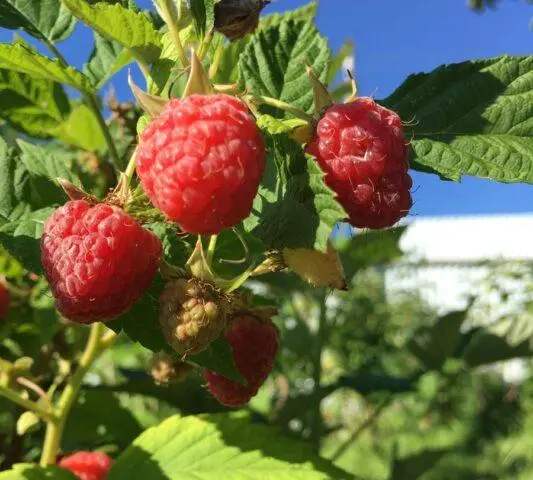
Raspberry Skazka requires molding at the beginning and end of each growing season
Mighty
The classic standard variety Krepysh (Krepish) with one powerful trunk, not counting the replacement shoots. Branching starts from 1/3 of the part, more intense towards the crown. Variety of remontant type, fruiting from June to September. It is characterized by good frost resistance up to -300 C, raspberries calmly react to drought and prolonged rains. The standard variety is grown from Siberia to the South, different climatic zones do not affect the taste of berries and the fruiting rate.
What does a raspberry look like?
- The plant is branched, reaches a height of 1,8 m.
- The berries are dark red, semi-oval.
- The structure is juicy, but not watery, elastic, sweet, the seeds are small.
- Fruits up to 18 g. Arranged densely on peduncles.
- Productivity – 4-5 kg.
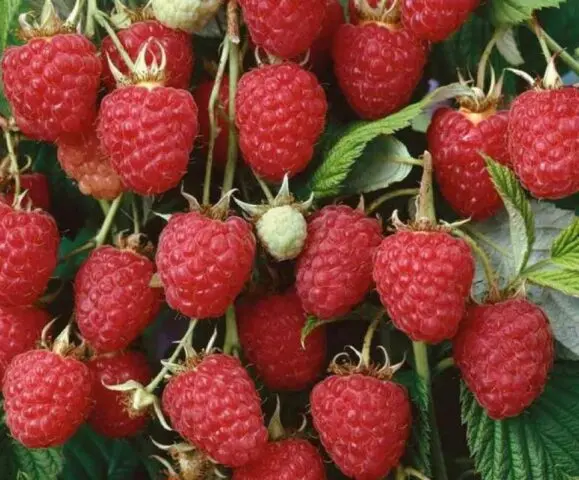
Raspberry Krepysh bears fruit on the site for about 12 years
Planting standard raspberries
Standard raspberries are planted in autumn only in the southern regions. Experts recommend identifying a seedling for a site in the spring (in April).
A place for raspberries is allocated sunny or with periodic shading. When planting linearly, leave a distance between standard varieties of at least 1,2 m. A wetland is not suitable for culture.
Sequence of work:
- Two weeks in advance, they dig up the soil, add organic matter, peat and sand.
- On the day of planting, they dig a hole 50×50 cm, mix the sod layer with humus, add superphosphate, wood ash.
- Part of the substrate is poured to the bottom, put the raspberries in the center, fill the pit to the brim.
- Seal and water with a solution that stimulates root growth. The neck is deepened by about 5 cm.
Standard raspberry care
Agrotechnics in varieties is standard, as in all varieties of crops. Cultivation differs only in the way of trimming the standard plant.
Watering

A large amount of moisture for raspberries is detrimental
Watering is guided by the frequency of rains, especially if the standard variety is drought-resistant. During the summer period, the plant is moistened up to five times with a volume of 30-40 liters so that the soil at a depth of 30 cm does not remain dry. This is the mode for adult raspberries, for seedlings in the first season they maintain soil moisture constantly, but do not allow stagnation. At the end of September, water-charging irrigation is carried out using 25 liters of water.
Additional fertilizing
Standard varieties are demanding on fertilizers, especially on organics. In the first year of growth, one root dressing is applied to raspberries. Mullein or bird droppings (0,5 kg) are mixed with complex mineral fertilizer (5 tablespoons), nitrophoska (2 tablespoons) is added, diluted in water (10 liters). One plant will require 2 liters.
In subsequent years:
- In early June, they give potassium sulfate, nitrophoska, liquid organics.
- In early July, potassium sulfate is added under standard raspberries.
- After picking the berries, fertilize with superphosphate.
When flowering ends and berries begin to pour, they are sprayed with Energen.
Pruning standard raspberries
When forming a stem culture, it is important to properly prune.
Algorithm:
- After planting, a central strong stem is selected, the remaining shoots are cut off.
- When the trunk reaches 1-1,2 m, pinch the top.
- On the standard part, all vegetative buds are removed. Leave only those where the crown will form from side shoots.
- In this form, raspberries hibernate.
- A crown will form next spring. If the variety is early, then the plant will bloom.
In autumn, it is advisable to cut the lateral stems on standard raspberries, leaving the required number of replacement buds, or remove the old stem part completely to the ground level. In the spring, the pruning scheme is repeated.
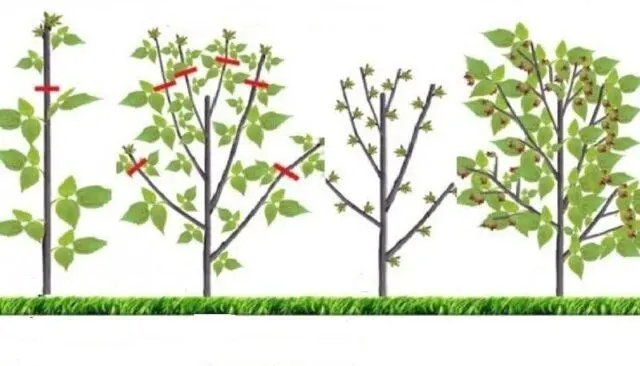
According to the Sobolev method, it is possible to form a raspberry tree with a two-year biological cycle
Mulching
In the first year of growth, standard raspberries cover the root circle with compost. Watering or rain erodes some of the mulch and the layer becomes thin. Its optimal thickness is 6 cm, so manure humus is added several times. Raspberries of reproductive age are mulched immediately after spring pruning. On damp soils, the surface is left open, regularly loosened, improving aeration. Remove weeds.
Preparation for winter
Standard raspberry, if it corresponds to the climate of growth in terms of frost resistance, the crown is not insulated. Fruiting shoots are simply cut off. Carry out water-charging irrigation, spud, cover with a layer of peat or sawdust, put straw on top, throw a snowdrift in winter. If a standard variety is grown in the form of a tree, if necessary, you can wrap the stem and skeletal part with covering material.
Protection against pests and diseases
At the end of the season, all remnants of weeds are removed and the soil is dug up so that wintering pests and fungal spores die. 10 days before frost, raspberries are treated with colloidal sulfur, and the soil with Karbofos. In the spring (before bud break), the root circle is abundantly watered with Topaz solution and covered with ash. After seven days, the raspberry will form young leaves, it is sprayed with any antifungal drug.
Reproduction of standard raspberries
It will not work to make layering, because the lower branches are high, it is difficult to bend down and cover them with soil. For the standard variety, you can use the cutting method. When the raspberry fully fructifies, it is cut off and the material is harvested. Placed in a container with a fertile substrate and lowered for the winter in the basement.
In the spring, the cuttings are taken out to the site. Swollen buds will show which material has taken root. At the end of August, raspberries are to be planted in a permanent place. Cuttings are an effective, but laborious method. Stamp varieties are often propagated by basal shoots. It is not much, but it is quite enough for landing.
Conclusion
Standard raspberries compare favorably with bush raspberries in terms of yield, frost resistance and undemanding to watering. All varieties are large-fruited, new varieties of remontant type. Raspberries with strong shoots do not require a fixing support. Special pruning allows the plant to grow into a tree shape.









